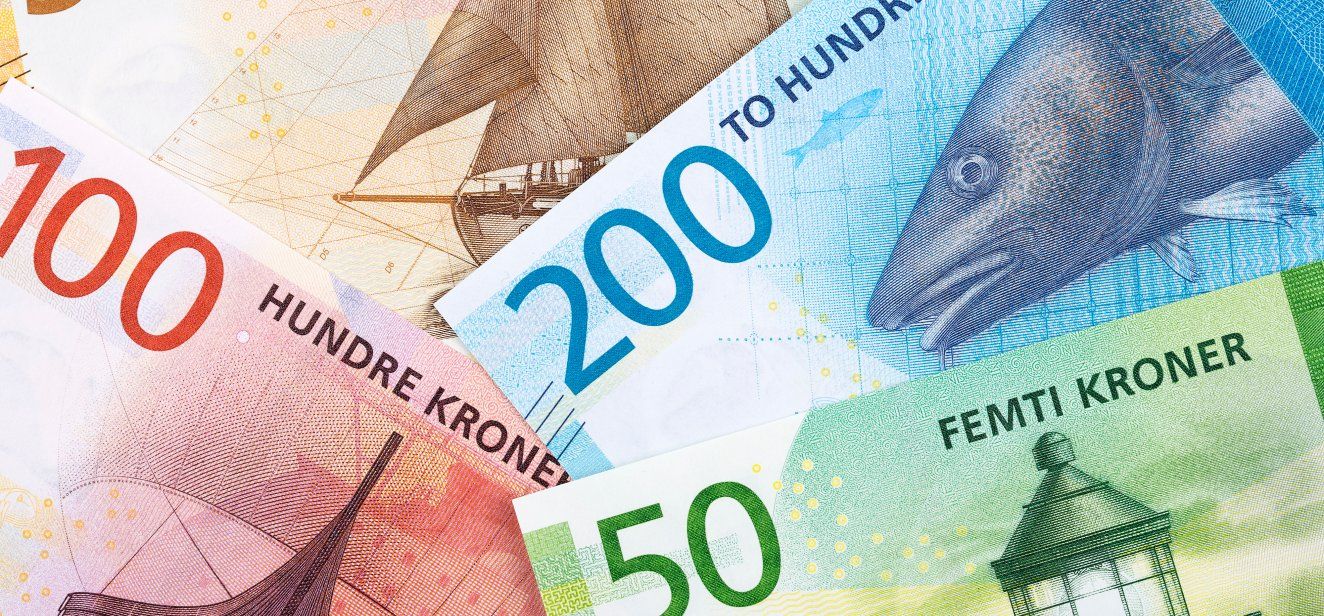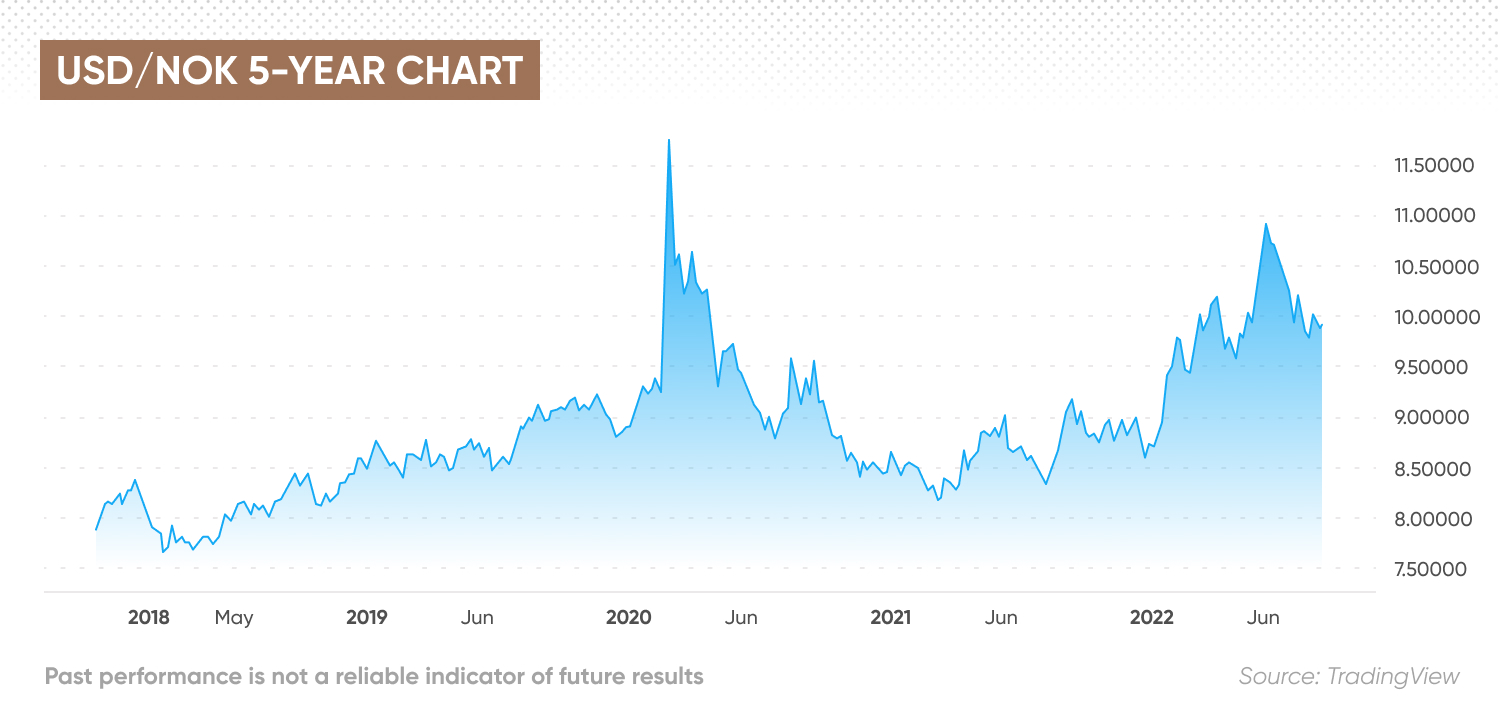USD/NOK forecast: Norwegian krone weakness driven by anticipation of Norges Bank breaking rate-hike cycle
Will the Norwegian krone rise or fall against the US dollar? Read on to learn more.
The Norwegian krone (NOK) has strengthened against the US dollar (USD) since the end of September on a combination of dollar weakness, high oil prices and lower foreign exchange purchases. The krone has gained around 10% against the US dollar, although it remains down by more than 12% since the start of 2022.
What drives the value of the krone against the dollar? And what is the potential outlook for the USD/NOK foreign exchange (forex) rate in 2023 and beyond?
What drives the value of USD/NOK?
In the forex markets, currencies are traded in pairs of base and quote currencies. The USD/NOK pair refers to how many Norwegian krone are needed to buy one US dollar. The USD is the base currency and the NOK the quote currency.
The US dollar is the world’s global reserve currency, which acts as a bellwether for the global economy and a safe haven during times of uncertainty. The value of the dollar has soared in 2022 as investors have sought to protect their wealth from the uncertainty caused by the Russia-Ukraine conflict and the prospect of a global recession. The dollar has also been lifted by an aggressive rise in US interest rates to address high inflation.
The Norwegian krone is one of the G10 currencies, which are the 10 most actively traded and liquid currencies on the forex markets. The G10 currencies no longer match the Group of Ten (G10) nations that provide financing to the International Monetary Fund (IMF).
Norway is the world’s third largest exporter of natural gas, behind Russia and Qatar, and a significant oil exporter. As such, the value of the Norwegian krone fluctuates in response to oil price movements. Interest rates in the US and Norway also influence the krone’s value, as higher interest rates make a currency more attractive for investors looking for higher returns on their funds through fixed income and other assets.
Krone turns higher on central bank policies
The USD/NOK exchange rate spiked to 11.79 in March 2020 as investors flocked to the safe haven of the dollar at the start of Covid-19 lockdowns and oil prices fell. The pair declined to 8.60 at the end of 2020 and dropped to 8.22 by May 2021 as economies reopened and oil prices rebounded on recovering demand.

The pair traded at 8.81 at the end of 2021. The rate hit 8.57 in March 2022 as the US raised interest rates by a total of 425 basis points since 17 March to a range of 4.25%-4.50%.
The USD/NOK pair moved above the 10 mark in July and pulled back to 9.52 in August on investor hopes of an easing in US interest rate hikes that proved to be premature. The pair moved up to 10.89 on 30 September, retreating to 9.71 on 14 December.
The USD/NOK was trading around 9.86 at the time of writing (20 December) after the Norwegian central bank sounded more hawkish than expected. Norges Bank raised its key interest rate by 25 basis points on 15 December to 2.75%, its highest level since 2009.
“Based on the Committee's current assessment of the outlook and balance of risks, the policy rate will most likely be raised further in the first quarter of next year,” the bank’s Monetary Policy Committee stated.
“The Committee assesses that a higher policy rate is still needed to dampen inflation… An easing of economic pressures will help curb inflation further out. Since the September Report, inflation has been higher than projected and is expected to remain high for longer than previously projected.”
Norway’s annual inflation rate came in at 6.5% in November, down from a 35-year high of 7.5% in October and below economists’ expectations of 7%, but above the 5.4% that Norges Bank had predicted for the fourth quarter.
"The forecasts for the Norwegian economy are more uncertain than normal, but if the economy evolves as anticipated, the policy rate will be around 3 percent next year," said Governor Ida Wolden Bache.
“As in Sweden, households are mostly homeowners and indebted at variable rates. This limits the possibility of raising rates without impacting the economy too much. Although far from its annual highs, crude oil prices remain high. The terms of trade remain favourable for the NOK,” analysts at French financial services firm BNP Paribas noted in November.
Norges Bank surprised the markets by announcing lower daily forex purchases for a second consecutive month in December, down to NOK1.9bn from NOK4.3bn in October and NOK3.7bn in November, indicating that the central bank is tolerating a stronger krone to limit imported inflation.
“This may at least partly denote appetite for a stronger domestic currency, which would help fight inflation as Norges Bank’s room for tightening may be restrained by Norway’s economic woes and vulnerable property market,” noted Francesco Pesole, FX strategist at the Dutch bank ING.
Norges Bank converts NOK excess petroleum revenues into foreign currency holdings – the US dollar and euro – primarily on behalf of Norway’s Ministry of Finance, which are then held by the Government Pension Fund Global (GPFG). Pesole commented:
“NOK is the least liquid currency in G10, which means it is extremely sensitive to global risk dynamics and financial conditions. While the deteriorating liquidity and risk environment in 2022 was the primary driver of NOK weakness, Norges Bank’s acceleration in FX purchases in September and October may well have added pressure on the krone.”
What is the potential outlook for the US dollar to Norwegian krone forecast in the future? Will the krone continue to strengthen, or will it pull back against the dollar?
USD/NOK forecast: Will the krone find long-term support?
Analysts’ forecasts for the USD/NOK rate range between 9.60-10.20 for the first quarter of 2023, and widen to an 8.60-10.20 range for the end of next year.
USD/NOK analyst forecasts
|
Q4 2022 |
Q1 2023 |
Q2 2023 |
Q3 2023 |
Q4 2023 |
|
|
Danske Bank |
- |
10.20 |
10.41 |
- |
10.20 |
|
Monex |
9.90 |
9.70 |
9.20 |
- |
8.60 |
|
SEB Group |
- |
10.10 |
9.71 |
9.42 |
9.33 |
|
Societe Generale |
- |
9.62 |
9.09 |
8.75 |
8.66 |
“In our view, a stronger domestic currency would be welcome in Norway as it would help fight elevated inflation… Norges Bank and the Finance Ministry may want to offer some support to NOK via lower FX purchases, with the aim of reducing the need for direct monetary policy action (rate hikes) to fight inflation. We could see Norwegian authorities keep FX purchases lower throughout 2023 for this reason, which would be a positive development for NOK,” ING’s Pesole said in the bank’s USD/NOK forecast.
“However, FX operations are one variable in the NOK equation, and crucially one with a lower weight compared to external factors that are well beyond Norges Bank’s control: global risk appetite and financial conditions. As discussed in our 2023 FX Outlook, worsening liquidity conditions are likely to pose a challenge to high-beta currencies such as NOK. Our base case is for NOK to appreciate to 9.60 against both EUR and USD by end-2023, but we doubt it will be a smooth ride for the krone."
“Next year, we expect the development for the NOK to be better. Bright spots for the NOK should be higher petroleum investments (implies increased NOK buying from oil companies), a reopening of China which we expect to happen during Q2 2023 (which would mean higher oil and gas prices), and central banks pausing their rate hikes after the historic rate hiking cycle in 2022. This would suggest somewhat better market sentiment next year than in 2022, which in turn supports a stronger NOK," noted a USD/NOK forecast analysis by the Finnish bank Nordea.
The USD/NOK forecast for 2023 from economic data provider Trading Economics projected that the pair could rise to 10.95791 in one year from 10.14871 by the end of this quarter, based on its global macro model projections and analysts’ expectations.
For the longer term, the USD/NOK forecast for 2025 from algorithm-based forecasting service Wallet Investor was bullish on the dollar at the time of writing, predicting that the pair could rise to 10.31, up from 9.844 at the start of 2023. The USD/NOK prediction indicated that the rate could climb further to 10.652 by the end of 2027.
But the USD/NOK forecast for 2030 from AI Pickup showed the pair moving down to 9.86 by the end of the decade from an average of 10.18 in both 2023 and 2025, and a peak of 10.75 in 2027.
Are you interested in a USD/NOK forecast to inform your forex trading? Remember that currency markets are highly volatile, making it difficult for analysts and algorithm-based forecasters to come up with accurate long-term predictions. Keep in mind that they can and do get their forecasts wrong.
We recommend that you always do your own research. Look at the latest market trends, news, technical and fundamental analysis, and expert opinion before making any investment decision. Keep in mind that past performance is no guarantee of future returns. And never invest money you cannot afford to lose.
Stay up to date with the major forex pairs using our currency strength meter.
FAQs
Why has USD/NOK been dropping?
The USD/NOK exchange rate has retreated from its high at the end of September as the Norwegian central bank has reduced its selling of the NOK to support the currency and reduce the impact of inflation, while also sounding a hawkish note on its interest rate hikes.
Will USD/NOK go up or down?
The direction of the USD/NOK rate in the future will likely depend, among other factors, on the Norwegian central bank’s policies on foreign currency reserves, interest rates and inflation, as well as international oil prices and economic sentiment, and the US central bank’s monetary policy.
When is the best time to trade USD/NOK?
You can trade currency pairs, including USD/NOK, around-the-clock. However, there are certain times when forex trading is most liquid. This usually occurs around the release of major economic announcements, such as trade data, inflation and interest rates, which often tends to drive volatility on forex markets higher. Keep in mind that high volatility increases risks of losses.
Is USD/NOK a buy, sell or hold?
How you trade the USD/NOK pair is a personal decision only you can make depending on your personal circumstances, risk tolerance and investing strategy. You should do your own research to take an informed view of the market. And never invest money you cannot afford to lose.